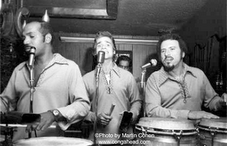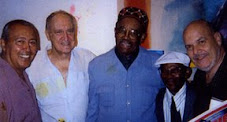 The dance floor, like the bandstand at the old La Conga nightclub, was the size of a postage stamp. Performing during the popular rumba matinees of the early forties, Noro Morales had to sit sidesaddle at his piano due to his corpulence and the cramped angle. The patrons came from the nearby fur market, garment center and millenary district. These were Jewish bosses with their Italian models. Four huge “palm trees” dominated the décor. Twenty-four round tables seating four were set so closely that conversations and casual comments overlapped, adding to a close congeniality even among business competitors.
The dance floor, like the bandstand at the old La Conga nightclub, was the size of a postage stamp. Performing during the popular rumba matinees of the early forties, Noro Morales had to sit sidesaddle at his piano due to his corpulence and the cramped angle. The patrons came from the nearby fur market, garment center and millenary district. These were Jewish bosses with their Italian models. Four huge “palm trees” dominated the décor. Twenty-four round tables seating four were set so closely that conversations and casual comments overlapped, adding to a close congeniality even among business competitors. “Rumbambola” had just ended. The perspiring dancers wriggled their way back to their tables like bouncing balls. In spite of the AC on full blast, everyone in the club was wringing wet. With a clever change of pace, Noro went into “Rumba Rumbero,” causing the exhausted couples to gulp down their drinks in order to hurry back onto the floor. One might say this was bad for business in a way. As soon as you sat down, you were up again like puppets on a string, manipulated by the cords of a musical magnetism: You were still jumping in bed that night.
When it became time to clear out for the dinner crowd (who had come to see Carmen Amaya, Diosa Costello, Jose Greco, Pedro Flores or Pedro Ramirez or Tondaleyo), the patrons were slow to leave. It was like emerging from a theater into sunlight. You were a performer! A star! One felt a reluctance, a disbelief like a shocking conclusion. You felt that “I want more” feeling until the rhythm slowly evaporated as you walked distractedly down Broadway. These were the same people who arrived early when the doors opened and while the band had not as yet shown up. The same people who would brave the heaviest rainstorm to dance carrying umbrellas into the club. Once settled, they would watch the musicians come in carrying their instruments over the heads of those at the tables. They would watch the band assemble. Testing, tuning, talking and turning to one another, the musicians were godlike, a congregation of talent. When the bongocero lit his Sterno, you knew you were in for a hot time. Noro, seated calmly at the piano; the dancers hushed at the tables—it was full artistic appreciation to watch things fall into place. This performance reached its climactic moment when Noro would raise his hand as if to say, as they do at the Indy 500: “Gentlemen, start your engines.”
(photo by William Gottlieb, 1947)

No comments:
Post a Comment